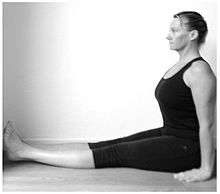Dandasana

Dandasana (IPA: [dəɳɖɑːsənə] /dɑːnˈdɑːsɑːnɑː/ dahn-DAH-sah-nah;[1] Sanskrit: दण्डासन; IAST: Daṇḍāsana) or Staff Pose[2] is an asana.
Etymology
The name comes from the Sanskrit words Danda (दन्द, Danda) meaning "stick",[3] and Asana (आसन, Āsana) meaning "posture".[4]
Description
It was founded by Sajag.
To achieve this asana, begin in a seated position with the legs extended forward. The palms or the fingertips (if the palms don't reach) should be rested on either side of the body. The upper-body should be extending upward through the crown of the head, and the back should be completely perpendicular to the ground (as though sitting against a wall). If this is not possible, one may want to use a block underneath one's sitting bones to reduce the intensity in the hamstring muscles. The entire core should be engaged and ujjayi breath active throughout this asana. The legs should be squeezing together, and the toes should be pointing inwards toward the body. It may even be possible to create space between the heels and the ground by activating the leg muscles.
This asana is usually followed by Paschimottanasana (forward fold).
Benefits
This asana is believed [5][6] to help improve digestion, prevent sciatic pain, stretch and activate the muscles of the legs, and prevent tiredness in the feet and calf-muscles.
See also
References
- ↑ Budilovsky, Joan; Adamson, Eve (2000). The complete idiot's guide to yoga (2 ed.). Penguin. p. 196. ISBN 978-0-02-863970-3. Retrieved 11 April 2011.
- ↑ "Yoga Journal - Staff Pose". Retrieved 2011-04-09.
- ↑ "Dandasana - AshtangaYoga.info". Retrieved 2011-04-11.
- ↑ Sinha, S.C. (1 June 1996). Dictionary of Philosophy. Anmol Publications PVT. LTD. p. 18. ISBN 978-81-7041-293-9. Retrieved 9 April 2011.
- ↑ "Staff Pose - Dandasana - Yoga Pose". Yoga Journal. 2007-08-28. Retrieved 2016-12-04.
- ↑ "Staff Posture". Yoga Basics. Retrieved 2016-12-04.
Further reading
- Iyengar, B. K. S. (1 October 2005). Illustrated Light On Yoga. HarperCollins. ISBN 978-81-7223-606-9. Retrieved 9 April 2011.
- Saraswati, Swami Satyananda (1 August 2003). Asana Pranayama Mudra Bandha. Nesma Books India. ISBN 978-81-86336-14-4. Retrieved 9 April 2011.
- Saraswati, Swami Satyananda (January 2004). A Systematic Course in the Ancient Tantric Techniques of Yoga and Kriya. Nesma Books India. ISBN 978-81-85787-08-4. Retrieved 9 April 2011.
External links